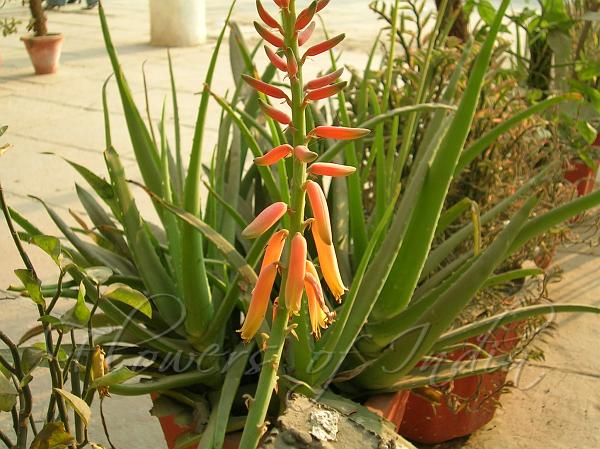|
| Aloe Vera |
|

|

| File size | 647548 |
| Original date | 1/1/06 4:09 PM |
| Resolution | 2048 x 1536 |
| Flash | Flash did not fire, auto |
| Focal length | 8.0mm |
| Exposure time | 1/96s |
| Aperture | 3.2 |
| Focus Distance | |
| Metering Mode | Partial |
| Camera make | NIKON |
| Camera model | E3700 |
| Sensor type |
|
|
|
Photo: Thingnam Girija |
Botanical name: Aloe vera Family: Asphodelaceae (Aloe family)
Synonyms: Aloe barbadensis, Aloe indica, Aloe vulgaris
Synonyms: Aloe barbadensis, Aloe indica, Aloe vulgaris
Aloe, a popular houseplant, has a long history as a multipurpose folk remedy.
Commonly known as Aloe vera, the plant can be snapped off and placed on cuts
and burns for immediate relief.
Aloe vera is a clump forming succulent whose fleshy gray-green leaves are arranged
in a vase shaped rosette atop a very short stem. The leaves are up to 18 in
long and 2 in wide at the base, slightly grooved on top,
and terminating in a sharp point. The leaves have small grayish teeth on the
margins. The main rosette gets up to about 2 ft high, and the plant
continually produces little offset rosettes. In winter and spring, medicinal
aloe bears small tubular yellow flowers on branched stalks up to 3 ft
tall. The real Aloe vera has yellow flowers, but many of the clones available
have orange flowers.
Although Aloe Vera is a member of the Lily
family, it is very-cactus like in its characteristics.
Medicinal uses: Aloe Vera contains over 20 minerals, all of which
are essential to the human
body. The human body requires 22 amino acids for good health -- eight of
which are called "essential" because the body cannot fabricate them. Aloe
Vera contains all of these eight essential amino acids, and 11 of the 14
"secondary" amino acids. Aloe Vera has Vitamins A, B1, B2, B6, B12, C and E.
In India, Aloe vera is believed to help in sustaining youth, due to its
positive effects on the skin. Hence it is called ghee kunvar or
ghee kumaari.
Aloe Vera contains over 20 minerals, all of which
are essential to the human
body. The human body requires 22 amino acids for good health -- eight of
which are called "essential" because the body cannot fabricate them. Aloe
Vera contains all of these eight essential amino acids, and 11 of the 14
"secondary" amino acids. Aloe Vera has Vitamins A, B1, B2, B6, B12, C and E.
In India, Aloe vera is believed to help in sustaining youth, due to its
positive effects on the skin. Hence it is called ghee kunvar or
ghee kumaari.
Medicinal uses:
 Aloe Vera contains over 20 minerals, all of which
are essential to the human
body. The human body requires 22 amino acids for good health -- eight of
which are called "essential" because the body cannot fabricate them. Aloe
Vera contains all of these eight essential amino acids, and 11 of the 14
"secondary" amino acids. Aloe Vera has Vitamins A, B1, B2, B6, B12, C and E.
In India, Aloe vera is believed to help in sustaining youth, due to its
positive effects on the skin. Hence it is called ghee kunvar or
ghee kumaari.
Aloe Vera contains over 20 minerals, all of which
are essential to the human
body. The human body requires 22 amino acids for good health -- eight of
which are called "essential" because the body cannot fabricate them. Aloe
Vera contains all of these eight essential amino acids, and 11 of the 14
"secondary" amino acids. Aloe Vera has Vitamins A, B1, B2, B6, B12, C and E.
In India, Aloe vera is believed to help in sustaining youth, due to its
positive effects on the skin. Hence it is called ghee kunvar or
ghee kumaari. | Identification credit: Thingnam Girija | Photographed in New Delhi |
• Is this flower misidentified? If yes,